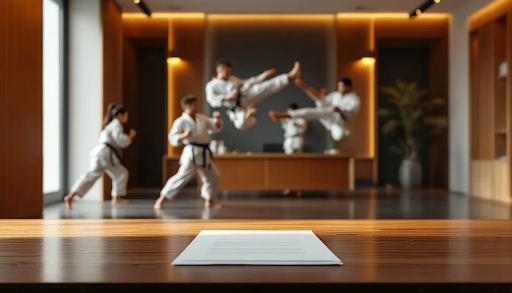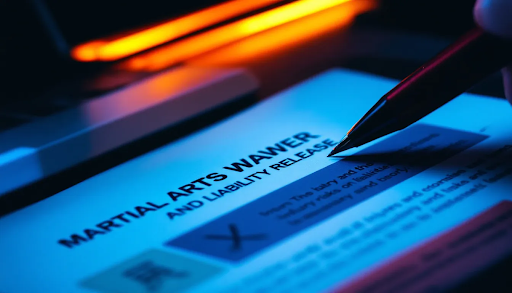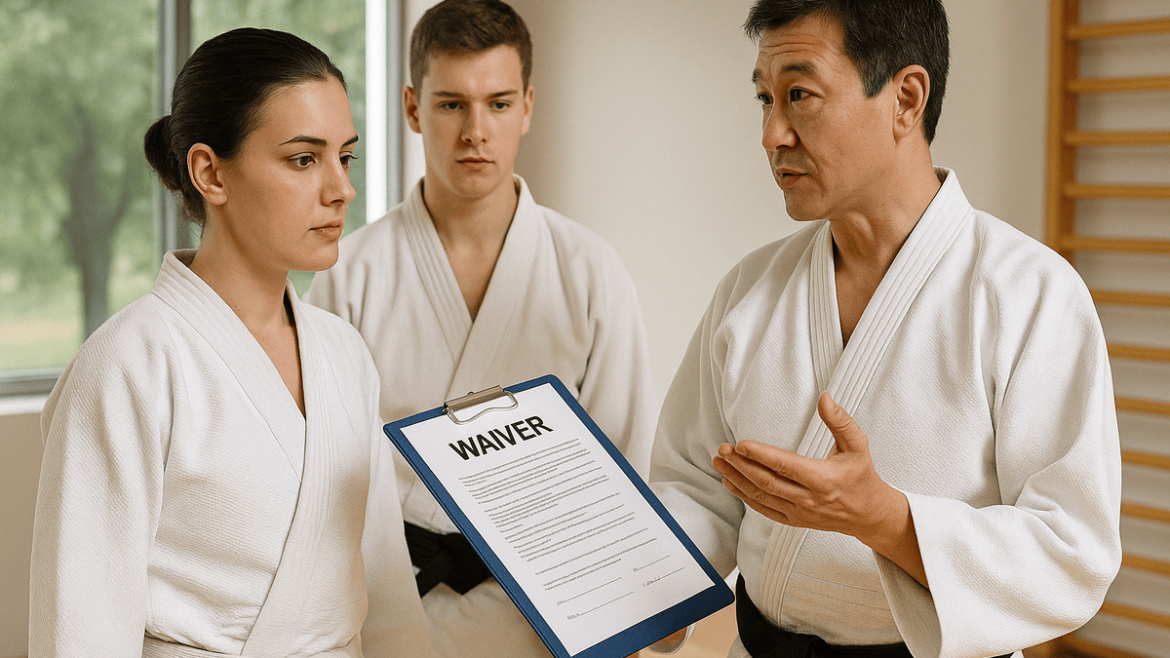Martial arts waivers protect schools from liability for student injuries. They outline the risks and ensure students can’t sue if hurt. This article explains their purpose, key elements, and legal considerations.
Key Takeaways
- Martial arts waivers are essential contracts that protect studios from legal liability for injuries by requiring participants to acknowledge and accept the risks involved.
- A comprehensive waiver should include participant information, an acknowledgment of risks, and a release of liability to ensure enforceability and legal protection.
- Digital waivers can enhance operational efficiency and record-keeping for martial arts schools, while regular reviews and updates are crucial to maintaining their legal effectiveness.
Understanding Martial Arts Waivers
Martial arts waivers are contracts designed to protect studios from being held accountable for injuries sustained by students during classes. The primary purpose of a liability waiver is to shield businesses from legal liabilities arising from the inherent risks associated with their services. In the context of martial arts, these waivers serve a critical function by outlining the dangers involved and obtaining the participant’s acknowledgment of these risks.
Many martial arts waivers include an assumption of risk clause, which allows studios to defend against lawsuits by asserting that students accepted the inherent risks of the activity. These waivers often require students to acknowledge these risks explicitly, which strengthens the school’s legal standing and increases the likelihood of a successful defense.
Signing a liability waiver means students agree not to hold the school liable for injuries, adding a layer of legal protection and law.
Why Martial Arts Schools Need Liability Waivers

Liability waivers are indispensable for martial arts schools as they help clarify the risks involved and protect the institution from legal claims. Requiring participants to acknowledge these risks shifts the responsibility for injuries to them. This is particularly crucial in martial arts, where the physical nature of the training inherently involves a higher risk of injury. Liability waivers legally binding help ensure that these agreements are enforceable.
In Mixed Martial Arts (MMA) gyms and other contact sports facilities, liability waivers act as a crucial defense mechanism, lowering legal risks and guarding against common lawsuits. Specifying the types of martial arts taught in the waiver is necessary to address the varying risk levels of each style.
Martial arts schools without a signed liability waiver face significant legal and financial consequences if a lawsuit occurs due to an injury or an accident.
Key Elements of a Martial Arts Waiver
A comprehensive martial arts waiver must include several key elements to be effective. These elements ensure that the waiver is legally sound and provides the necessary protection for the school. The primary components include participant information, acknowledgment of risks, and a release of liability.
Each element plays a crucial role in the waiver’s enforceability and must be carefully tailored to the martial arts school’s specific needs.
Participant Information
One of the fundamental components of a liability waiver is the participant information section. This section should include the participant’s name, contact details, and date of birth, which are essential for identification purposes. For minors, a parent or legal guardian must sign the waiver, as minors cannot legally sign it themselves. Including this information ensures that the liability form and waiver are personalized and specific to the individual, which enhances its enforceability.
Additionally, collecting detailed participant information helps the martial arts school maintain accurate records, which can be crucial in the event of an incident. It allows the school to quickly identify the participant and their guardian, facilitating timely communication and resolution of any issues that may arise. This level of detail also demonstrates the school’s commitment to professionalism and preparedness, which can further protect against potential legal challenges. Schools can encourage participants to participate in safety training sessions to enhance their preparedness.
Acknowledgment of Risks
The acknowledgment of risks section is arguably the most critical part of the liability waiver. This section should outline the inherent risks associated with martial arts training, providing specific scenarios to ensure participants fully understand the dangers involved, including specific risk factors. Clearly stating these risks allows participants to make informed decisions about their readiness to engage in martial arts activities.
A well-crafted waiver will use clear and explicit language to describe the risks, often employing:
- Numbered or bullet lists to enhance comprehension.
- Safety tips to emphasize the importance of safety.
- Equipment suggestions and safety measures to further reinforce risk management.
This approach not only ensures that participants understand the risks but also reinforces how the waiver protects the enforceability in court, and the participant agrees to these terms.
Failing to clearly outline the risks can significantly weaken the waiver’s effectiveness and leave the school vulnerable to legal claims. Therefore, it is essential to be thorough and specific when drafting this section, ensuring that all potential hazards are adequately addressed. This practice helps protect the school from liability claims and promotes a culture of safety among participants.
Release of Liability
The release of liability clause is another crucial component of an effective martial arts waiver. This clause ensures that participants agree not to hold the martial arts school liable for any injuries or damages incurred during training or events. For the waiver to be enforceable, it must be clear and specific about the rights being waived and the associated risks.
Clear language in this section is essential, explicitly stating that participants release the martial arts school from any liability for injuries. The general liability waiver should also clarify that this release does not cover injuries resulting from gross negligence or intentional harm by the school. This distinction is crucial, as waivers cannot protect against extreme negligence or intentional actions, and including such a clause can strengthen the waiver’s legal standing.
Signing the release forms of liability signifies participants’ understanding and acceptance of the risks associated with martial arts training, agreeing to hold the school harmless in the event of an injury. This agreement helps protect the school from potential lawsuits and reinforces the importance of personal responsibility among participants. The releases help clarify these responsibilities.
Drafting a Legally Sound Martial Arts Waiver

Drafting a legally sound martial arts waiver requires careful attention to detail and a thorough understanding of legal principles. The waiver should begin with a clear introductory statement that addresses the agreement’s purpose. This sets the tone for the document and ensures that participants understand its significance.
Signatures and relevant dates of the agreement are essential to make the confirmation section of the waiver legally binding. Including a statement confirming that participants understand and accept the waiver’s terms is also important. The use of clear language, short paragraphs, and numbered or bullet lists can enhance the clarity and readability of the waiver, including the signs of understanding and agreements.
Best practices for electronic waivers include:
- Using simple language to ensure clarity
- Ensuring voluntary agreement from participants
- Having the waiver reviewed by a legal professional to ensure its legal soundness and compliance with local laws
- Providing a separate section for signing on behalf of minors
Digital vs. Paper Waivers: Which Is Better?
In today’s digital age, many martial arts schools are transitioning from paper to digital waivers. Digital waivers offer numerous advantages, including convenience and efficiency. They streamline the waiver process, allowing participants to sign online and reducing the chance of lost paperwork. Digital waivers also enhance record-keeping, making it easier to organize and retrieve documents when needed.
Decide between digital and paper waivers requires considering the specific needs of your martial arts school. For larger schools with high student turnover, digital waivers are particularly beneficial as they simplify the administrative process.
However, in some cases, paper waivers may still be relevant, such as for a specific event or participants who prefer a physical document. Ultimately, the choice depends on the school’s operational preferences and participants’ needs, including different types of waivers.
The Role of Waivers in Insurance Risk Reduction
Waivers play a crucial role in reducing insurance risks for martial arts schools. A well-structured liability waiver can lead to lower insurance premiums, as insurers view these waivers as indicators of effective risk management. Enhancing transparency about the risks encourages students to act responsibly during training, further mitigating potential liabilities.
Insurers assess a gym’s risk based on its injury history and the strength of its liability waivers, which influences policy costs and claim outcomes from an insurance company. Additionally, waivers can cover various events hosted by martial arts schools, such as tournaments and summer camps, managing additional risks.
Digital waivers, in particular, help mitigate legal risks associated with missing or incomplete paper forms.
Implementing Waivers in Your Martial Arts School
Implementing waivers in your martial arts school is a critical step toward ensuring legal protection and operational efficiency. A properly crafted waiver reflects professionalism and preparedness, which can enhance the school’s reputation and trustworthiness. For minors, a parent or legal guardian must provide their signature on the liability waiver, ideally with the guidance of a lawyer.
Collecting emergency contact information is also vital in case of an incident during martial arts activities. Digital waivers streamline operations within the business company organization by allowing students to sign online, reducing the chance of lost paperwork and ensuring easy access to documents. For example, this first aid service process can significantly enhance safety and efficiency.
Compliance checks are easier with digital documents, as they can be organized and audited more efficiently. Seeking legal documents advice when creating waivers ensures compliance with local laws and prevents potential legal issues.
Common Mistakes to Avoid with Martial Arts Waivers
Avoiding common mistakes when creating and implementing martial arts waivers is essential for their effectiveness. One frequent error is using overly broad language, which can lead to unenforceability in court. Waivers must be specific and clear about the risks and responsibilities involved to be legally binding.
Ensuring that participants sign the waiver voluntarily is also crucial, as any indication of coercion can result in challenges to its enforceability. Schools often neglect to update their waivers to reflect changes in laws or practices, risking legal protection. Regular review and updates ensure waivers remain effective and compliant with current legal standards.
Legal Considerations for Martial Arts Waivers
Legal considerations are paramount when drafting and implementing martial arts waivers. The enforceability of a waiver may depend on its clarity and the specific circumstances of an injury. Waivers do not provide complete protection; they mainly serve as a layer of legal defense against claims of negligence. Factors influencing enforceability include clarity, specificity, voluntary acceptance, and highlighting inherent dangers.
State courts may scrutinize the validity of waivers, especially if they believe they may discourage studios from maintaining safety standards. Ignoring state-specific legal requirements for waivers can lead to significant vulnerabilities in liability protection. Consulting a legal expert ensures the waiver complies with local laws and includes all necessary elements.
Summary
In conclusion, martial arts waivers are indispensable tools for protecting schools from legal and financial risks. By clearly outlining the inherent risks of martial arts training and obtaining participants’ acknowledgment and acceptance of these risks, waivers provide a crucial layer of legal defense. Key elements of an effective waiver include participant information, acknowledgment of risks, and release of liability.
Implementing waivers, whether digital or paper, enhances operational efficiency and demonstrates professionalism. Regularly reviewing and updating waivers ensures they remain effective and compliant with legal standards. By prioritizing the creation and implementation of comprehensive waivers, martial arts schools can safeguard their operations and focus on providing a safe and enriching training environment.
Frequently Asked Questions
What is the primary purpose of a liability waiver in martial arts?
The primary purpose of a liability waiver in martial arts is to protect martial arts schools from legal liabilities stemming from the inherent risks involved in the practice. This ensures that participants acknowledge and accept these risks.
Why is it important for minors’ guardians to sign the waiver?
It is crucial for minors’ guardians to sign the waiver because minors are not legally capable of entering into contracts, making the guardian’s signature necessary for the waiver to be enforceable. This ensures that the legal protections are upheld for both the minor and the entity involved.
How can digital waivers benefit martial arts schools?
Digital waivers significantly enhance the efficiency of martial arts schools by streamlining the waiver process and improving record-keeping while minimizing the risk of lost paperwork. Implementing digital waivers is a practical step toward optimizing administrative tasks in your facility.
What are some common mistakes to avoid when creating waivers?
Avoid using overly broad language and ensure that waivers are signed voluntarily; also, regularly update them to reflect any changes in laws or practices. This will help maintain their validity and effectiveness.
How do waivers complement insurance policies for martial arts schools?
Waivers complement insurance policies for martial arts schools by enhancing transparency about risks and promoting responsible behavior, which can also contribute to lower insurance premiums through effective risk management.

